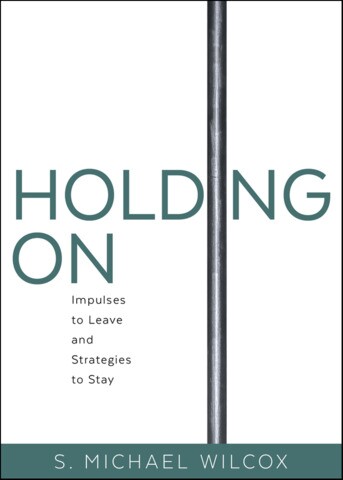I remember vividly my first “faith crisis.” I was 14 or 15 years old. It centered on my desire to receive for myself, independent of my mother, a testimony of the Book of Mormon. Except for a period of rebellion when she left the moorings of her youth and wandered in the wilderness for a season, she was a believing, committed Latter-day Saint and the godliest woman I knew. The solid base of her faith was the Book of Mormon, which restored her to her roots and anchored her there for the rest of her life. I can’t recall a day when I did not see that book lying on her bed stand or on the lamp table next to her chair. I started reading the Book of Mormon fully expecting that its concluding promise would be fulfilled in my life as it had been in my mother’s. I was filled with Alma’s “desire to believe” (Alma 32:27). I wanted my own tree.
To my distress, all was darkness. My soul filled with doubt, creating deep anxiety. What if it is not true? I asked myself. Why can’t I feel the peace and assured whisperings of the Holy Ghost?
It was summer, and I was working on my uncle’s ranch in Nevada. We took Sundays off, had our own church meetings, and rested the remainder of the day. I would take the Book of Mormon onto the lawn under the shade trees and read. Sunday after Sunday the fear spread. I would go into the willows by the river and plead with God to take the doubts away and tell me what I longed to hear. I was answered with silence! Then more silence and still silence! I remember being bothered by certain words and names like Anti-Nephi-Lehis, and this voice inside my head was telling me Joseph Smith made it all up. I was terrified. I couldn’t talk to anyone. My mother was in California, and I don’t think I would have dared unveil my fears to her. I didn’t finish my reading that summer. Somewhere in Alma the despair became great enough that I closed the book and turned my thoughts to horses, baseball, and girls.
Had I been older, would things have turned out differently? Would I have followed the impulse to leave? I had friends who left at that age. Yet I could see my mother with her abiding love of the book that now sat in the bunkhouse unopened. I eventually returned to the Book of Mormon, but it would be another five years, on the brink of my mission, before I received the witness I desperately wanted that summer in Nevada.
I don’t know why I had to go through that. Was it a lesson of endurance, of staying, of wanting something badly enough that you don’t give up until you receive it? Perhaps it was God teaching me that sometimes we have to pray through the darkness before the pillar of light appears—pray to the edge of “despair”—to the “moment of great alarm” (Joseph Smith—History 1:16). That is the first great lesson of the Restoration! The young Joseph in the grove believed he would get an answer but instead was overcome with darkness. Yet he prayed through it—“exerting all my powers to call upon God to deliver me . . . , and at the very moment when I was ready to sink into despair . . . just at this moment of great alarm, I saw a pillar of light” (Joseph Smith—History 1:16). There is something good, necessary even, about exerting all our powers when surrounded by forces with “such an astonishing influence” (Joseph Smith—History 1:15). We pray through the darkness until the light appears. This has happened more than once in my life. Light lives in darkness!
Hinds’ Feet on High Places
Sometimes the road of faith thins into precipices at the edges. The straight path narrows to barely a foothold. The pain of offenses and gravity of doubt pull at us. During these times of praying through darkness, we must simply hold on. When the boy of the grove became a man locked in Liberty Jail, he cried, “O God, where art thou?” “How long?” he asked. The Father’s answer was, “Hold on thy way” (Doctrine and Covenants 121:1–2, 122:9). Through a life of persecution, betrayal, pain, accusation, the death of children, and tragic setbacks, Joseph always held on.
There is a little-known prophet in the Old Testament named Habakkuk. He faced a crisis of faith also and, with foreshadowing echoes of Liberty Jail, asked, “O Lord, how long shall I cry, and thou wilt not hear!” (Habakkuk 1:2). He was challenged by the age-old question of why an all-powerful, all-loving God allows the righteous to suffer at the hands of the wicked. Questioning the character and nature of God, Habakkuk was answered: “The just shall live by his faith” (Habakkuk 2:4). Living by faith requires patience. Relief will eventually come: “Though it tarry, wait for it; because it will surely come” (Habakkuk 2:3).
When your ledge of faith is reduced to toeholds, visualize the image used by Habakkuk at the end of his little book. Though reason for belief may diminish and doubt dominate, “the Lord God is my strength, and he will make my feet like hinds’ feet, and he will make me to walk upon mine high places” (Habakkuk 3:19). The image is of a “hind,” a deer or other hoofed animal, swiftly and securely walking upon narrow mountain trails. “High places” refers to the spiritual levels of our lives—the sacred places.

On the cliffs of the Judean wilderness, a species of wild goat known as the ibex walks on the tiniest ledges. It is impressive watching them, and the words of Habakkuk enter my mind. In Glacier National Park I have hiked the high trails to watch through binoculars as the mountain goats maneuver dangerous ridges and near-90-degree slopes. In Italy, the Alpine ibex climb along impossible, almost vertical ledges, licking the surface of the Cingino Dam for nutrients and minerals needed to maintain their health. I fix these images in my mind when asked to live by faith and “tarry.”
Habakkuk encourages us to live by whatever tiny lips of faith we have. Like the ibex, we need nutrients—spiritual nutrients that are found in “high places.” We “hold on” until the path widens. I have learned that it always does. Borrowing from another metaphor, we cling to the iron rod through the mists when the tree is obscured. The scriptures have multiple examples of people who held on when circumstances and challenges to their faith could have tempted them into disbelief or bitterness. Think of Joseph sold into Egypt or the multiple expulsions of the Saints. Our love of Jesus can provide a particularly firm holding place. When we are struggling to hold on, when we can’t seem to find our spiritual nutrients, we can focus on our love for Christ and the Father and Theirs for us. Their love is a firm holding place.
If those dark moments in the willows at my uncle’s ranch were the first of my life, they were not the last. When my wife, my beautiful Laurie, died 10 years ago, my path narrowed. Unease and hidden fears crept into my mind, troubling me when alone at night. All my hopes and happiness rested on the beliefs of my chosen religion and the path I had walked since childhood. They rested on temple ordinances, promises, and authority vested in a temple sealer. They rested on the assurances of life after death and an eternal family. Was there a Laurie? Was she still mine? Did Joseph Smith teach revealed truth when he introduced celestial marriage?
► You may also like: What 1 of Christ's questions taught S. Michael Wilcox after his wife's passing
This is an ongoing battle. I pray through the darkness for the pillar of light. I pray for hinds’ feet to stay on those high places that promise eternal reunion and everlasting love. The rope of faith upon which I hang has knots in it to which I can cling, but the knots sometimes seem to unravel. When that happens, I have to hold on so very much tighter. I wish I could say these struggles with faith are all resolved, but I continue from time to time to wrestle with questions and anxieties. Yet I can testify that over time my path has widened, sometimes imperceptibly. Time has proved a healer and comforter. I do so desire complete resolution and believe it will come, but it may, for me, come in eternity.
Our paths do widen. Not always as soon as we hope, but they widen, and the climbing becomes easier. The knots reform. When doubts or interruptions to your rejoicing come—hold on with your hinds’ feet. Grip tightly! Walk the high places. “Though it tarry, wait for it; because it will surely come.”
Lead image: Shutterstock.
In this book, author S. Michael Wilcox shares six strategies to cope with honest doubts and help us grow our faith in the gospel of Jesus Christ. Drawing on his own personal faith journey as well as lessons from scripture, history, and literature, Holding On is an insightful, honest, and empathetic conversation about faith and doubt. The messages in this book urge us to hold onto faith, center the essentials, and resist the impulses to leave—and stay. Available at Deseret Book stores and on deseretbook.com.





